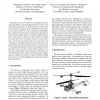Free Online Productivity Tools
i2Speak
i2Symbol
i2OCR
iTex2Img
iWeb2Print
iWeb2Shot
i2Type
iPdf2Split
iPdf2Merge
i2Bopomofo
i2Arabic
i2Style
i2Image
i2PDF
iLatex2Rtf
Sci2ools
CSIE
2009
IEEE
2009
IEEE
Supervised Control of a Flying Performing Robot Using Its Intrinsic Sound
We present the current results of our ongoing research in achieving efficient control of a flying robot for a wide variety of possible applications. A lightweight small indoor helicopter has been equipped with an embedded system and relatively simple sensors to achieve autonomous stable flight. The controllers have been tuned using genetic algorithms to further enhance flight stability. A number of additional sensors would need to be attached to the helicopter to enable it to sense more of its environment such as its current location or the location of obstacles like the walls of the room it is flying in. The lightweight nature of the helicopter very much restricts the amount of sensors that can be attached to it. We propose utilising the intrinsic sound signatures of the helicopter to locate it and to extract features about its current state, using another supervising robot. The analysis of this information is then sent back to the helicopter using an uplink to enable the helico...
Related Content
| Added | 20 May 2010 |
| Updated | 20 May 2010 |
| Type | Conference |
| Year | 2009 |
| Where | CSIE |
| Authors | Benjamin N. Passow, Sophy Smith, Mario A. Góngora, Adrian A. Hopgood |
Comments (0)

